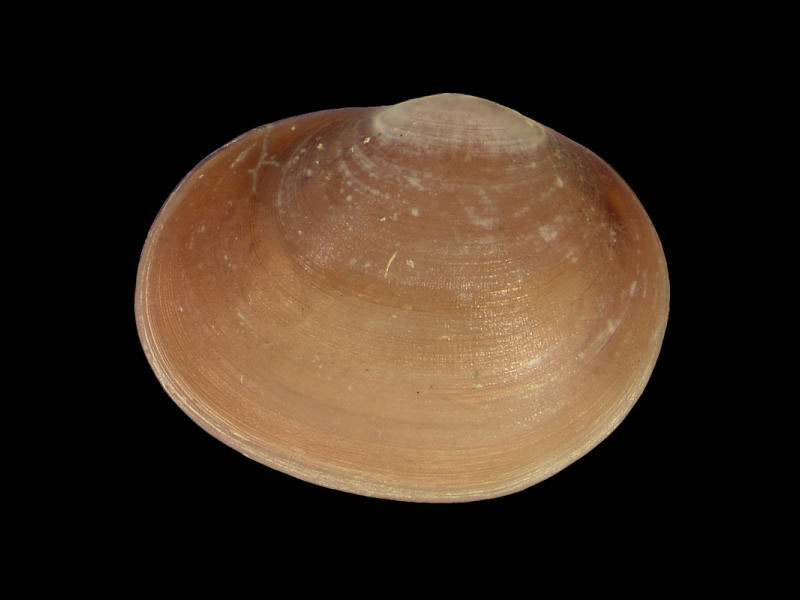A bivalve mollusc (Lasaea adansoni)
Distribution data supplied by the Ocean Biodiversity Information System (OBIS). To interrogate UK data visit the NBN Atlas.Map Help
| Researched by | Dr Harvey Tyler-Walters | Refereed by | Admin |
| Authority | (Gmelin, 1791) | ||
| Other common names | - | Synonyms | Lasaea rubra (Gmelin, 1791) |
Summary
Description
Recorded distribution in Britain and Ireland
Found on all rocky coasts of Britain, except the south east, presumably due to a lack of suitable habitat. Also found amongst mussels on sedimentary shores and recorded from the shingle beaches of the Fleet, Dorset. Probably under recorded.Global distribution
It is widely distributed in north-west Europe. Lasaea adansoni (as rubra) has been recorded in the Kerguelan Islands, South Antarctic, and the variant Lasaea rubra himenoa is found in New Zealand.Habitat
Lasaea adansoni is a crevice or interstitial dwelling bivalve. It is found in high numbers in intertidal crevices. It also occupies interstices between mussels and barnacle shells, in the holdfasts of macroalgae (e.g. Fucus spp.), in the fronds of small algae and especially amongst tufts of the lichen Lichina pygmaea. It is most abundant in the upper and mid-shore, decreasing in numbers near high and low water.Depth range
-Identifying features
- Left valve with one cardinal tooth but none on the right valve.
- Beaks slightly posterior.
- Umbones rounded with a large prodissoconch.
Additional information
The genus Lasaea is cosmopolitan in distribution and composed of numerous species, which may be local variations of Lasaea adansoni (= rubra). Gosling (1994) suggested that species within this genus should be referred to as Lasaea rubra complex.Listed by
- none -
Bibliography
Fish, J.D. & Fish, S., 1996. A student's guide to the seashore. Cambridge: Cambridge University Press.
Gosling, E.M., 1994. Speciation and wide-scale genetic differentiation. In Genetics and evolution of aquatic organisms, (ed. A.R. Beaumont), pp.1-15. London: Chapman & Hall.
Hayward, P., Nelson-Smith, T. & Shields, C. 1996. Collins pocket guide. Sea shore of Britain and northern Europe. London: HarperCollins.
Hayward, P.J. & Ryland, J.S. (ed.) 1995b. Handbook of the marine fauna of North-West Europe. Oxford: Oxford University Press.
Howson, C.M. & Picton, B.E., 1997. The species directory of the marine fauna and flora of the British Isles and surrounding seas. Belfast: Ulster Museum. [Ulster Museum publication, no. 276.]
Datasets
Bristol Regional Environmental Records Centre, 2017. BRERC species records recorded over 15 years ago. Occurrence dataset: https://doi.org/10.15468/h1ln5p accessed via GBIF.org on 2018-09-25.
Centre for Environmental Data and Recording, 2018. Ulster Museum Marine Surveys of Northern Ireland Coastal Waters. Occurrence dataset https://www.nmni.com/CEDaR/CEDaR-Centre-for-Environmental-Data-and-Recording.aspx accessed via NBNAtlas.org on 2018-09-25.
Conchological Society of Great Britain & Ireland, 2018. Mollusc (marine) data for Great Britain and Ireland - restricted access. Occurrence dataset: https://doi.org/10.15468/4bsawx accessed via GBIF.org on 2018-09-25.
Conchological Society of Great Britain & Ireland, 2018. Mollusc (marine) records for Great Britain and Ireland. Occurrence dataset: https://doi.org/10.15468/aurwcz accessed via GBIF.org on 2018-09-25.
Fenwick, 2018. Aphotomarine. Occurrence dataset http://www.aphotomarine.com/index.html Accessed via NBNAtlas.org on 2018-10-01
National Trust, 2017. National Trust Species Records. Occurrence dataset: https://doi.org/10.15468/opc6g1 accessed via GBIF.org on 2018-10-01.
NBN (National Biodiversity Network) Atlas. Available from: https://www.nbnatlas.org.
OBIS (Ocean Biodiversity Information System), 2024. Global map of species distribution using gridded data. Available from: Ocean Biogeographic Information System. www.iobis.org. Accessed: 2024-05-14
Citation
This review can be cited as:
Last Updated: 17/10/2005



